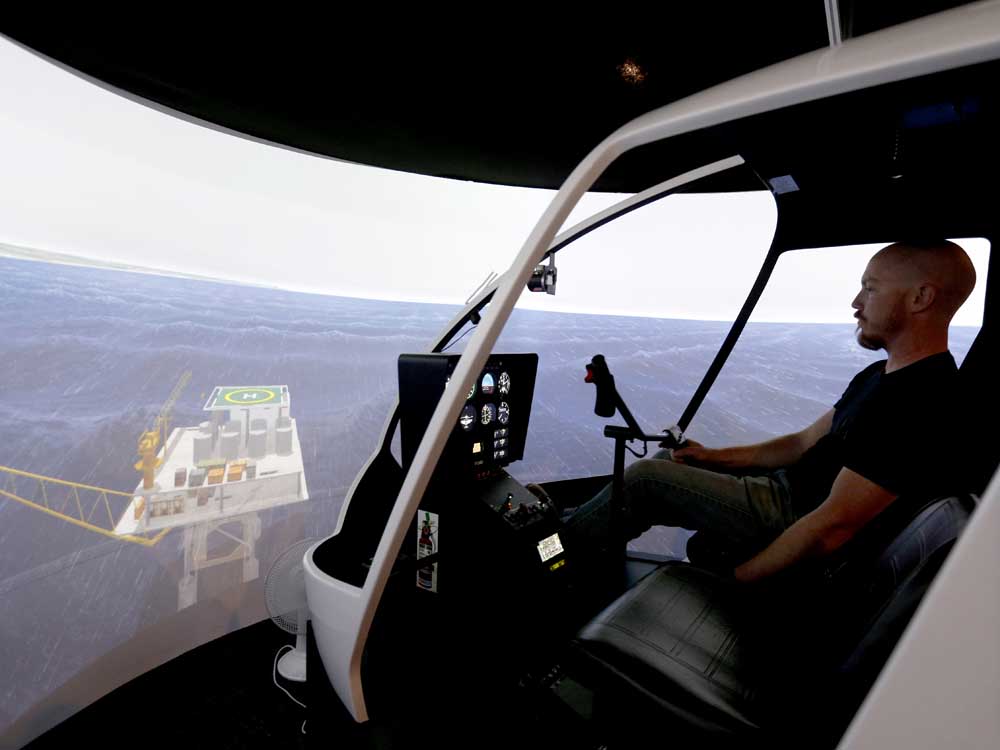Helicopter simulator up and running at COCC
Published 12:00 am Tuesday, November 8, 2016

- Joe Kline / The Bulletin COCC aviation student Michael Whittaker attempts to land on a helipad on screen while operating a helicopter simulator at Leading Edge Aviation in Bend.
A new helicopter simulator Central Oregon Community College bought in the spring is up and running for aviation students.
This fall marks the first full quarter with the simulator, and now, more of the time students spend on it can count toward flight time. Students in the aviation program get into a real helicopter or airplane about the third week of the semester.
Trending
“Simulators are essentially an aviation training device,” said Karl Baldessari, COCC’s aviation program director.
There are different levels for training devices, Baldessari explained. The lowest level could be as simple as a desktop computer, while the highest could be a simulator one can go inside, like stepping into a cockpit, that rests on hydraulics so there is movement.
At $400,000, COCC’s new device falls in between those levels, but sits at the higher end of the spectrum.
The footprint of the new simulator is about 20 feet by 20 feet, Baldessari said, so it looks like a cockpit but is much more open. The screen the user views to practice flying is about 8 feet high in a 180-degree semicircle to feel more like a real windscreen. It has seats, consoles and an instrument panel like a real helicopter — the Robinson R44. Students learning to fly airplanes, as opposed to helicopters, train on a separate device modeled after an airplane.
The flight instructor working with helicopter students generally sits behind them. The student controls the simulator’s flight movements, but the instructor can change conditions, including the weather and the scenery — whether the student is flying over land or ocean, for example.
Baldessari said students have been excited trying out the new simulator, adding that some are surprised by it. Just as simulators are different from really flying, simulators differ from one another, too.
Trending
“They love the fact that it’s something they can control and fly a little easier,” he said, comparing it with the old device. The old helicopter trainer the college had was more like a 90-inch flat screen TV with a cockpit chair in front of it.
“The detail involved with this thing is way, way greater than our previous simulator,” Baldessari said. “It truly flies like an aircraft.”
The heightened level of the new simulator increases the number of hours that can be counted toward individual certifications for students. And the device, certified by the Federal Aviation Administration in the spring, can potentially help save students money. If a student wants extra hours in a cockpit beyond what’s included in the aviation program, they can use the simulator and pay less than they would for extra lessons in a real helicopter.
“Unless they were in the military, it’s probably the best they’ve used,” Baldessari said.
Last month, Michael Whittaker, a student in COCC’s aviation program, met up with Dustin Ballard, a certified flight instructor with COCC, at Leading Edge Aviation in northeast Bend next to Bend Municipal Airport, where the new simulator is located. Leading Edge partners with the community college for the aviation program.
As Ballard fired up the simulator, Whittaker, 27 and of Bend, checked all of the controls to make sure everything was working. Baldessari, also on site for that lesson, explained the images the simulator shows on the screen mimic the Newport Municipal Airport on the coast and its surrounding area. That way students simulate flying in an area somewhat nearby, but they also get experience of flying over the ocean and landing on ships.
The software on the simulator allows students to fly in most of the “popular areas” in Oregon and Washington, Baldessari said. A student could practice landing on a hospital in downtown Portland, for example.
“You can do maneuvers like hovers whereas you couldn’t before,” Baldessari said. As the screen in front of Whittaker turned mostly white, Baldessari explained he was flying through the clouds. Ballard had brought up a storm with his controls to challenge the student so that he would have to use only his instruments to fly instead of vision, too. Ballard instructed Whittaker to land on an offshore oil rig on the screen.
“This is an advanced maneuver,” Baldessari said, adding it was Whittaker’s first time doing it. “You’re trying to land on something that looks the size of a postage stamp.”
Through the rain appearing on the screen Whittaker began to lower the aircraft with precision.
“Shoot it to a point before the pad,” Baldessari said, reminding his student.
Although Whittaker had only been in the simulator a couple times before that lesson, being in a real helicopter is nothing new to him. As a veteran, Whittaker said he logged close to 600 hours in Cobra and Huey helicopters in the Marine Corps, although not as a pilot, but a crewman.
Baldessari said he estimates about 70 percent of his students are military veterans.
The aviation program costs about $75,000 for students studying to be airplane pilots and $100,000 for those studying to be helicopter pilots, including flight fees. Helicopter lessons are more expensive for two main reasons, Baldessari said: maintenance and insurance. Helicopters have a lot more moving parts to maintain, and because they are flown closer to the ground, insurance is higher.
Now, Baldessari said the aviation program is looking to update its airplane simulator next, perhaps in the spring.
— Reporter: 541-383-0325,
kfisicaro@bendbulletin.com








